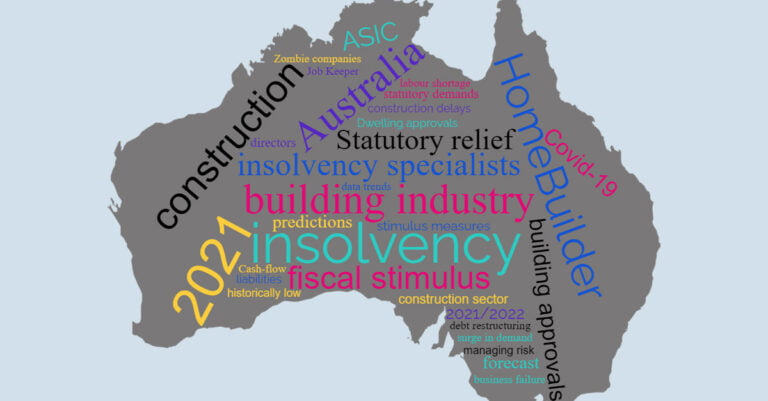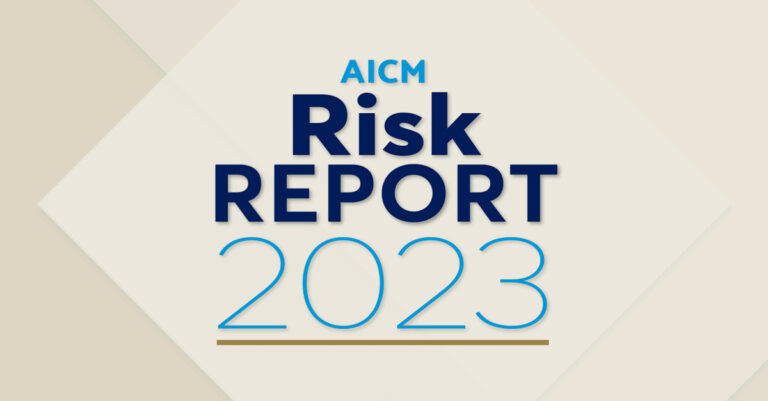
CREDIT INSIGHTS
Builder Collapse Avalanche Picking Up Speed

Executive Director Wayne Clark was recently interviewed by Phil Bartsch for this article which was published in “The Urban Developer” on April 14, 2023.
The insolvency avalanche has regained momentum in Australia’s construction industry and still in its path are hundreds of companies precariously teetering on the brink of collapse.
New data indicates insolvencies in the sector are trending to surpass 2000 for the 12 months to the end of June—the highest in more than a decade.
“I’d say that the vast majority of builders and construction businesses in Australia are probably borderline insolvent—technically, that is,” Building Industry Credit Bureau chief executive Wayne Clark says.
“Cashflow is probably keeping most of them alive … it just depends on what their balance sheets look like but we’re seeing a slowdown in the payment patterns for sure.”
According to Clark, the latest BICB analysis shows Australia’s construction industry is now averaging 170 insolvencies per month, up from 160 insolvencies per month in February.
“So we’ve had to revise our forecast upwards,” he says. “Based on the modelling we’re doing at the moment, if you extrapolate that out you end up with about 2040 insolvencies nationally by the end of the current fiscal year.”
That equates to a massive 37 per cent jump in insolvencies across the beleaguered sector compared to the 1282 liquidations, receiverships and administrations recorded in 2021-2022 by the Australian Securities and Investments Commission.
It also is well above the decade-high national tally of 1802 insolvencies in 2013-14.
Newly-released statistics from ASIC show 1538 construction-related companies have entered administration or had a controller appointed in the nine months to March 26—dwarfing the 818 company collapses recorded for the same period last financial year.
Two years ago, the warnings from the industry’s coalface were loud and clear.
“Much worse is to come. This is just the start … it’s a shambles,” Scott Hutchinson, the chairman of Australia’s largest private construction company, Brisbane-based Hutchinson Builders, told The Urban Developer at the time.

“It’s getting ready to explode and for people to go down.”
He wasn’t wrong, unfortunately.
Pandemic-driven supply chain disruptions, a construction pipeline super-charged by government stimulus, soaring building material costs, rising interest rates and inflation, as well as crippling delays due to record wet weather and labour shortages have taken their toll.
It has led to an escalating insolvency domino effect as the growing list of industry casualties has left behind scores of creditors—including many sub-contractors—owed hundreds of millions of dollars.
Association of Professional Builders cofounder Russ Stephens also saw the red flags of what was coming back in mid-2021 and declared: “It will be biblical”.
“You could see it building up,” he says. “And when you’re going into a massive upturn it’s much worse than going into a downturn where building companies would have reacted by capping their expenses, running things down and tight.
“But in the last couple of years a lot of the big builders have done the absolute opposite and ramped up, which is how they’ve all got caught out so quickly.”
Stephens says excess cashflow generated from new construction “can mask a multitude of problems, including huge losses over a period of a year or so”.
“From the outside, what we’ve been seeing is building companies continuing to trade and look okay because they’ve got positive cashflow and they’re paying their sub-contractors and suppliers on time.
“But below the surface, they’ve been losing money—in some cases, huge amounts of money because of the fixed price contracts they’ve signed.

“In the Covid boom, we saw large companies signing three, four or five times the amount of contracts they would normally sign … [and] those contracts have been queued up over two to three years and they’ve probably lost up to 30 per cent on some of them because of the compounded increase in construction costs.
“Now, effectively, what we’re seeing is a construction Ponzi scheme,” he says.
“When you’re not profitable, you’re losing money and you’re using new cash inflows to pay old creditors, that’s the definition of a Ponzi scheme.
“As sales start to slow down, which we are starting to see in the industry now, then the cash inflows slow up and that’s why we’re starting to see a few more big ones go under.”
In the past six months alone, a new swathe of construction firms have gone to the wall.
In December, construction giant Clough—a Perth-based contractor involved in some of Australia’s biggest infrastructure projects, including the Snowy 2.0 hydropower project—collapsed owing creditors about $250 million.
Its sudden demise has been followed in the ensuing months by a rising tide of subsequent failures with a sobering post festive season surge of big and small companies going under in quick succession.
High-end Sydney housebuilder EQ Projects called in administrators in February owing up to $50 million to about 500 creditors.
Among the other casualties in the first two months of the year were Perth building company Hamlen Homes with $1.4 million owed to creditors, Melbourne-based Hallbury Homes with between $8 million and $12 million of outstanding debt, troubled Sydney homebuilder Ajit Constructions and Brisbane’s Pantha Homes and LCD Pty Ltd.

Less than 24 hours after abruptly stopping work and shutting down its construction sites, PBS Building—headquartered in Canberra but also with offices in Sydney and Brisbane—went into voluntary administration in early March with 80 projects on its books. Initial estimates indicated creditors were owed $40 million but further investigations revealed the company’s debts totalled more than $60 million.
“We are the latest, but we won’t be the last construction group to buckle under the weight of a broken industry and way of doing business that needs urgent reform,” the troubled company’s founder Ian Carter noted at the time.
Sure enough, within a few weeks two other major industry players had fallen over.
Melbourne-based civil construction firm Lloyd Group was placed into voluntary administration putting 59 projects—many of them major local and state government contracts—in limbo in Victoria and New South Wales.
Only hours earlier, one of the nation’s largest project home builders Porter Davis Homes Group collapsed, leaving 1700 homes unfinished in Victoria and Queensland after an eleventh-hour bid to secure a buyer or financial backer to prop up the company failed. It is understood the company owes 1000-plus secured and unsecured creditors more than $25 million.
Meanwhile, a subsequent rescue offer from Melbourne real estate investor MIG Sons and Co founder Amit Miglani has been rejected as “not credible” by liquidators, who have said there had been no viable offers to acquire the entire Porter Davis business and customers are to be offered a shortlist of builders who might be able to complete their homes.
Clark says Porter Davis had been on the radar of the BICB—which ranks among its members some of the building industry’s biggest suppliers—for several months before its demise.
“We knew that Porter Davis was a problem,” he says. “That was being reflected in the data that we were getting from our members that were trading with them. We could see the slowdown in their payments over a period of time. It wasn’t drastic, but it was definitely an increase in the amount that they had outstanding … certainly since Christmas.”
Clark says the construction industry now accounts for about 31 per cent of all insolvencies—up from 26 per cent last financial year—and there has been a substantial rise in the accumulation of debt above 60 days.
“We’re expecting that to go higher,” he says. “We know there’s quite a lot of cashflow issues at the moment … the potential for bad debt is huge.

“We’ve definitely seen a shift from around about November-December last year.
“Total debt outstanding above 60 days has gone up probably 3 to 3.5 per cent in the last few months … that’s a pretty big increase and a significant amount of money when you’re looking at $2.4 billion worth of trading data a month.”
Clark says the pain is being felt “across the board … the entire industry”.
“However, we do expect to see possibly another one or two of the larger project home builders go under. That’s just speculation … but we do know there’s plenty of pain and that particular sector is carrying the brunt of it.”
Stephens agrees there is still a world of hurt ahead in coming months for the industry.
“The effect of that is the building companies that are still in business that have got orders placed with those sub-contractors that get wiped out by these large companies, they’ve now got to place orders with other sub-contractors.
“And typically at higher prices, which again will affect their profitability so it’s a terrible domino effect, apart from all the distress and anguish it causes these companies that are going under.”
Stephens, whose company provides buisness advice to residential builders, says financial education is a “big black hole” in the industry.
“It’s what blindsides a lot of building companies,” he says.
“We’ve got people starting building companies and coming into the industry, handling millions and millions of dollars in revenue but working on wafer thin margins.
“You’ve got to be very, very vigilant and understand your numbers to operate any business that has high revenue, low margin. And there’s just not enough financial understanding.
“It’s an ongoing problem that’s been in the industry for decades … [and] we’re never going to get that financial understanding to where it needs to be until we make it compulsory.”
Clark says the danger signals were flashing as soon as the federal government introduced the HomeBuilder program in mid-2020.
“We knew it was going to overstimulate the market, drag demand forward and cause building material and labour costs to increase because of huge demand on those things
“And they did it right in the middle of a worldwide pandemic when China—where a lot of our building materials come out of—pretty much had shutdown.
“So we saw problems right away … and we knew there was always going to be a period where the piper needed to be paid.”
That time of reckoning in the industry has come hard and fast.
“We think it might peak sometime around about June, July or August,” Clark says.
“Then we might start to see the numbers [of insolvenies] reduce slightly but it’s probably not going to come down massively. And it’s going to take at least the rest of the year and probably the first few months of next year to work its way through the system.
“But I’m looking at the graph now and it’s still moving north.”







